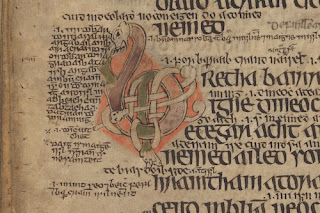It was produced in 697 from the Synod of Birr, a gathering of clerics and secular figures, Irish, Pictish, and Dal Riatan. It was likely called by Adomnán himself, based on his authority as the abbot of Iona.
Although designed to protect the innocent, it was unforgiving of the guilty. Section 33 of one of the two remaining manuscripts (both of a later date than the 7th century) is particularly harsh, and relates how an angel demanded rules to protect women:
Go forth into Ireland, and make a law in it that women be not in any manner killed by men, through slaughter or any other death, either by poison, or in water, or in fire, or by any other beast, or in a pit, or by dogs, but that they shall die in their lawful bed...
For whoever slays a woman shall be condemned to a twofold punishment, that is, his right hand and his left foot shall be cut off before death, and then he shall die, and his kindred shall pay seven full cumals*, and one-seventh part of the penance. If, instead of life and amputation, a fine has been imposed, the penance is fourteen years, and fourteen cumals shall be paid. But if a host has done it, every fifth man up to three hundred shall be condemned to that punishment; if few, they shall be divided into three parts. The first part of them shall be put to death by lot, hand and foot having been first cut off; the second part shall pay fourteen full cumals; the third shall be cast into exile beyond the sea, under the rule of a hard regimen;
Women were not assumed to be angels, either. A woman who murdered, stole from a church, or tried arson, would be condemned to be pushed from shore in a boat with one oar and some gruel. This was considered a way to avoid killing a woman, and left her fate up to God (shades of Antigone!).
Section 50 deals with non-death offenses:
If it be rape of a maiden, seven half-cumals (is the fine) for it. If a hand (is put) upon her or in her girdle, ten ounces** for it. If a hand (is put) under her dress to defile her, three ounces and seven cumals for it. If there be a blemish on her head or her eyes or in the face or in the ear or nose or tooth or tongue or foot or hand, seven cumals are (to be paid) for it. If it be a blemish on any other part of her body, seven half-cumals are (to be paid) for it. If it be tearing of her dress, seven ounces and one cumal for it.
The Synod of Birr brought together different ethnic groups that we therefore assume were Christian. One group mentioned was the Picts, a name with which everyone may be familiar, but who were they? What was their relation Scottish and British and Irish people? Are they still around, and did they leave us any lasting monuments? Let's try to figure out what we really know about the Picts, and why were they called that? See you tomorrow.
*A cumal represented the value of three milch cows.
**The "ounces" are of silver.


